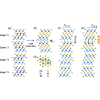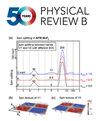四层 MnBi2Te4 反铁磁体中的层间铁电极化调制反常霍尔效应
IF 3.7
2区 物理与天体物理
Q1 Physics and Astronomy
引用次数: 0
摘要
范德瓦耳斯(vdW)组装可以有效地调节二维(2D)材料的对称性,这种对称性最终决定了它们的物理特性。尤其令人感兴趣的是,适当的范德华组装引入了铁电极化,从而实现了二维材料的新型电子、磁性和传输特性。四层体状堆叠反铁磁性锰铋碲(MnBi2Te4,FB-MBT)为探索铁电极化对纳米材料磁序和拓扑输运特性的影响提供了一个极好的平台。本文通过对称性分析和密度函数理论计算,分析了铁电界面对 FB-MBT 的磁序、反常霍尔效应(AHE)甚至量子 AHE(QAHE)的影响。FB-MBT 中的层间铁电极化通过赋予磁电耦合有效地违反了 FB-MBT 的 P ̂T ̂ 对称性(中心反转 (P ̂) 和时间反转 (T ̂) 对称性的组合),并稳定了 FB-MBT 中包含铁磁界面的特定反铁磁秩序。我们预测,在 FB-MBT 的顶部或底部界面设计层间极化可以将 FB-MBT 从微不足道的绝缘体转换为切尔绝缘体。中间界面铁电极化的切换会导致量子反常霍尔电流的方向逆转。此外,顶部和底部界面的层间极化可以朝同一方向排列,极化方向的切换也会使反常霍尔电流的方向反转。总之,我们的研究工作凸显了二维 vdW 四层反铁磁体通过 vdW 组装而产生的量子传输现象。这些现象在 MnBi2Te4 的块状或薄膜状堆叠形式中是不存在的。本文章由计算机程序翻译,如有差异,请以英文原文为准。

Interlayer ferroelectric polarization modulated anomalous Hall effect in four-layer MnBi2Te4 antiferromagnets
Van der Waals (vdW) assembly could efficiently modulate the symmetry of two-dimensional (2D) materials that ultimately governs their physical properties. Of particular interest is the ferroelectric polarization being introduced by proper vdW assembly that enables the realization of novel electronic, magnetic, and transport properties of 2D materials. Four-layer bulklike stacking antiferromagnetic (-MBT) offers an excellent platform to explore ferroelectric polarization effects on magnetic order and topological transport properties of nanomaterials. Here, by applying symmetry analyses and density-functional-theory calculations, the ferroelectric interface effects on magnetic order, anomalous Hall effect (AHE) or even quantum AHE (QAHE) on the -MBT are analyzed. Interlayer ferroelectric polarization in -MBT efficiently violates the symmetry [the combination of central inversion () and time reverse () symmetry] of the -MBT by conferring magnetoelectric couplings, and stabilizes a specific antiferromagnetic order encompassing a ferromagnetic interface in the -MBT. We predict that engineering an interlayer polarization in the top or bottom interface of -MBT allows converting -MBT from a trivial insulator to a Chern insulator. The switching of ferroelectric polarization at the middle interfaces results in a direction reversal of the quantum anomalous Hall current. Additionally, the interlayer polarization of the top and bottom interfaces can be aligned in the same direction, and the switching of polarization direction also reverses the direction of anomalous Hall currents. Overall, our work highlights the occurrence of quantum-transport phenomena in 2D vdW four-layer antiferromagnets through vdW assembly. These phenomena are absent in the bulk or thin-film in bulklike stacking forms of .
求助全文
通过发布文献求助,成功后即可免费获取论文全文。
去求助
来源期刊

Physical Review B
物理-物理:凝聚态物理
CiteScore
6.70
自引率
32.40%
发文量
0
审稿时长
3.0 months
期刊介绍:
Physical Review B (PRB) is the world’s largest dedicated physics journal, publishing approximately 100 new, high-quality papers each week. The most highly cited journal in condensed matter physics, PRB provides outstanding depth and breadth of coverage, combined with unrivaled context and background for ongoing research by scientists worldwide.
PRB covers the full range of condensed matter, materials physics, and related subfields, including:
-Structure and phase transitions
-Ferroelectrics and multiferroics
-Disordered systems and alloys
-Magnetism
-Superconductivity
-Electronic structure, photonics, and metamaterials
-Semiconductors and mesoscopic systems
-Surfaces, nanoscience, and two-dimensional materials
-Topological states of matter
 求助内容:
求助内容: 应助结果提醒方式:
应助结果提醒方式:


